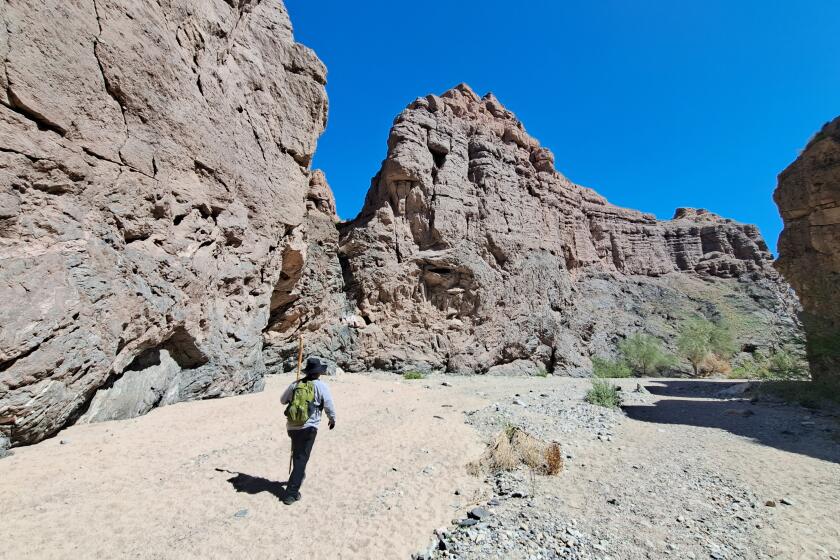Thomas Tortez Jr. leads a group across a gravelly wash in Painted Canyon, at the spot where his Cahuilla tribal ancestors once lived in a village.
The solar eclipse is underway. Suddenly, a strange yelp echoes from a ridge of craggy outcroppings.
Perhaps the yelp comes from a hiker who’s been struck with awe while climbing ladders into terraced slot canyons that seem to funnel echoes to the heavens.
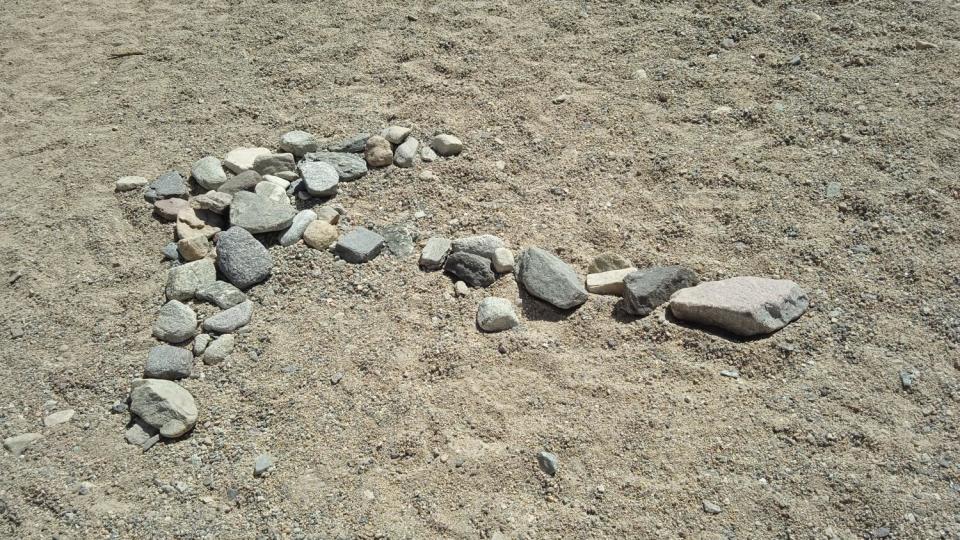
Maybe it’s a coyote crying out as the moon passes partway in front of the sun, briefly cooling the dry desert wind and bathing bands of red, sandstone and iron green rocks in an otherworldly light.
Or might it be Mukat, the exiled Cahuilla creator god who roamed among the ironwoods, smoke trees, palo verdes and ghost flowers?
Tortez, tribal council chairman of the Torres Martinez Desert Cahuilla Indians, spikes the sand with the desiccated yucca stalk that he’s repurposed as a walking stick. He seems at ease with the mystery of the sound and the mystique of this section of the Mecca Hills Wilderness.
His people have cherished and watched over this canyon in the eastern Coachella Valley for thousands of years. Now they are among the Indigenous Californians, conservationists and other nature lovers who want President Biden to designate 627,855 acres of desert where the canyon sits as the Chuckwalla National Monument.
Rep. Raul Ruiz, a Democrat who represents the desert communities in eastern Riverside and Imperial counties that border the proposed land mass, joined with California Sens. Alex Padilla and Laphonza Butler in introducing legislation to support the creation of the monument and to expand Joshua Tree National Park by 17,915 acres.
Chuckwalla sits at the heart of a burgeoning ecological and economic zone — a short drive from the city of Indio and the date farms of Mecca, and near the vast mineral flats and off-grid settlements of the Salton Sea and the towering Santa Rosa Mountains. It would become the fifth-largest land-based national monument in the continental U.S.
In announcing the legislation on the steps of the U.S. Capitol this month, Padilla said he was especially gratified that a coalition came together to craft the monument proposal — Indigenous leaders, community members, environmental groups, recreationists, renewable energy companies and local businesses.
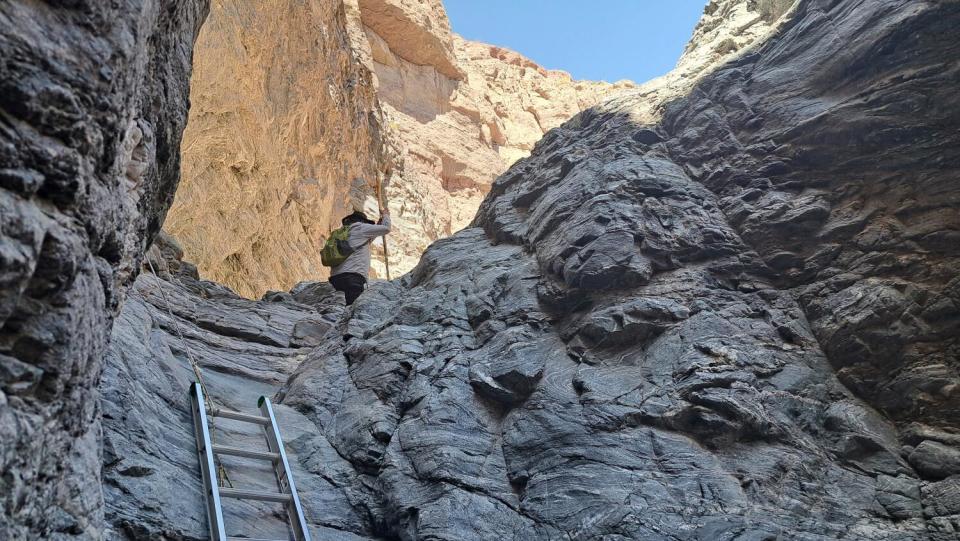

Speaking later by phone, Ruiz touted the monument as important for helping California meet its conservation and climate change goals without encroaching on public lands already designated for other uses, such as green energy projects. Ruiz says his congressional district produces the most renewable energy on federal land in the U.S.
Evidence of these intersecting interests is clear in Chuckwalla, where power lines channeling electricity from solar farms farther east cut across the land.
Ruiz says the design of the monument proposal is distinct in that it gives Indigenous tribes the power to co-manage Chuckwalla alongside the federal Bureau of Land Management.
“In Congress, I really have seen a movement toward incorporating tribal, Indigenous knowledge in land stewardship,” Ruiz says.
Read more: Their stolen land in Orange County was given back. Now they’re ready to heal
Co-existence doesn’t come without tension. In another section of desert south of the Salton Sea, construction has started on a $1.85-billion lithium mine and geothermal power plant, prompting some pushback from residents there who argue that developers haven’t adequately weighed the impacts on the environment and public health.
Tortez says pushing for Chuckwalla’s monument designation is hugely important to tribes, given that so many are vying for a stake in the region’s future.
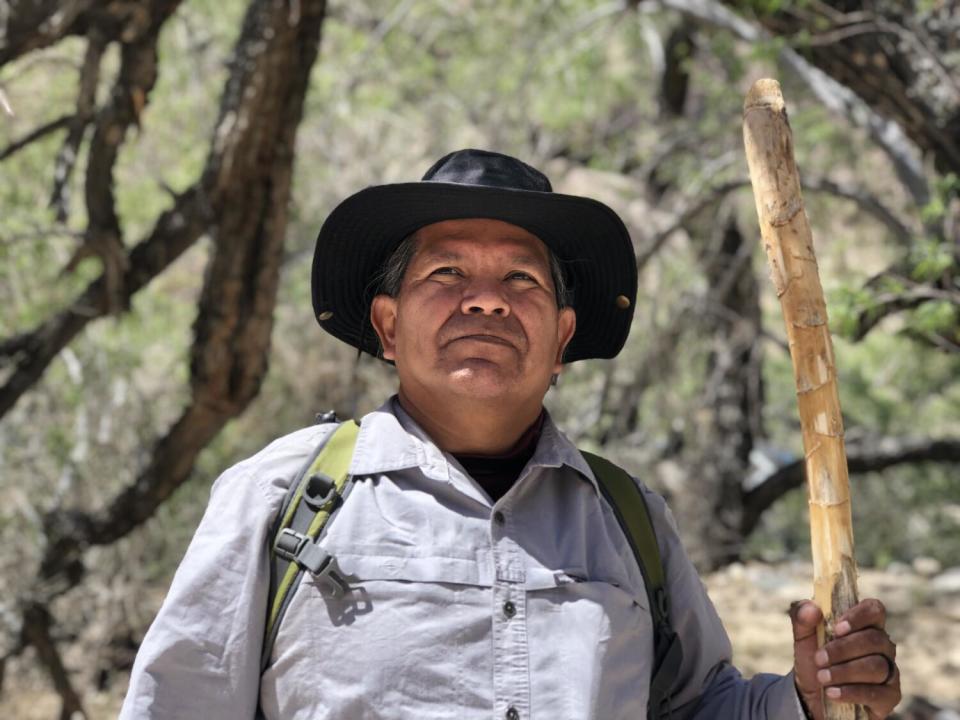

Members of the Cahuilla, Chemehuevi, Mojave, Quechan and Serrano nations who call the California desert home worked together to call for Biden to establish the monument using the authority granted to presidents under the Antiquities Act of 1906, which was enacted to safeguard threatened cultures as well as precious lands. The Fort Yuma Quechan Indian Tribe wants Biden to use the same authority to establish 390,000 acres of their ancestral land in Imperial County as the Kw’tsán National Monument.
Tortez says the Antiquities Act was written for places like these.
He notes how bands of rock swirl and stack on top of each other and jut skyward at gravity-defying angles. It’s all the result of millions of years of sediment flows, soil erosion and the endless clash of the San Andreas Fault’s two plates.
“It’s like a timepiece — chapters in history,” he says of the open-faced geology of this canyon.
This place holds the ancestral memory of tribal members too.
The landscape may look desolate and unforgiving to an outsider — a setting where Chuckwalla lizards, cactus wrens and western tanagers thrive — but for the Cahuilla it is a paradise.
According to the Cahuilla creation story, Tortez says, the people of this desert were born from a bolt of lightning that lit up the sky and flooded the empty land with life.
“Even the darkness is alive,” he says. “There’s a spirit there.”
Tortez says that his Cahuilla elders on the Torres Martinez reservation, which is a short drive down the hill, acclimated themselves to the arid conditions and 100-degree-plus summer temperatures. They would trek great distances between hidden streams and through slots as narrow as alleyways in order to build up their resistance to extreme thirst.
“You would think of it as odd now, but they would practice not drinking water,” says Tortez, 62. “My mom was born on the reservation — there were no hospitals back then. She remembers running around in the desert barefoot on dirt roads. Imagine doing that now.”
Read more: Black farmer looks to ancestors to help Californians battle climate change
The Cahuilla learned to live in harmony with all aspects of the ecosystem. They gathered plants and seeds for food and medicine, cut grass to weave baskets and built steps leading to wells to retrieve groundwater. They cremated their dead on wood funeral pyres for three days, to purify the bodies of the deceased and transition their souls back into the Earth.
The Cahuilla also charted trade corridors reaching from the Colorado River to the shores of the Pacific, where coastal tribes traded shell jewelry for obsidian tools and animal skins from the interior.
The ancient trails still exist, Tortez says. Southern Californians know them as State Route 74, which runs west from Palm Desert to the ocean, and Interstate 10, which skirts Chuckwalla’s northern edge.
Tortez’s ancestors didn’t need paved roads or signs. As a young man, he was amazed to learn from older relatives of how ancestors could travel from one hill to the next, through disorienting expanses of sand and rock, yet never lose their bearings.
“If you can imagine, they can remember when their grandparents were able to run up to the mountains with a message and come back down with another message, like it was nothing, like going to Wal-Mart,” Tortez says with a chuckle.
As Tortez contemplates Chuckwalla’s richness, another member of the hiking group, Stephanie Dashiell, an environmental consultant who is manager of the national monument campaign, spots a thorny ocotillo growing high on a cliff.
The canyon is even more awash in colors than usual because of the frequent winter rains: blueish lupines, indigo bushes, pinkish-purple sand verbena, golden desert poppies, powdery desert lavender, mallow blossoms in creamy orange, lemon-yellow brittlebush.
Dashiell, 43, steps in close to enjoy a creosote bush’s telltale aroma of black tar and sand after a storm. With seeds that look like tiny cotton balls, the plant can produce clones of itself for hundreds or even thousands of years.
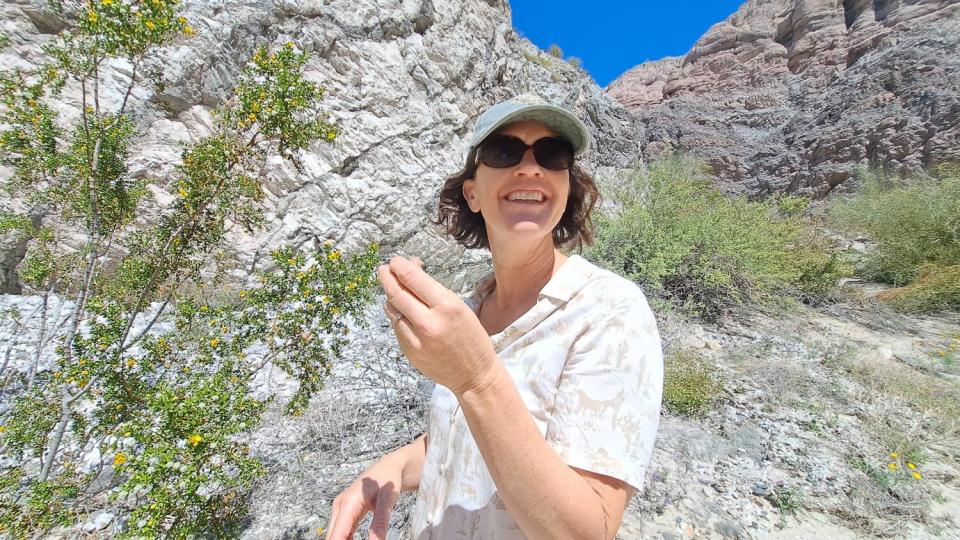

The flora seen in Chuckwalla are true survivors.
“The plants here have so much grit,” Dashiell says. “There’s not that much left in the Coachella Valley that’s natural like this, where you just have the native species and it hasn’t been transformed into agriculture or golf courses. The desert is really important.”
Even the desert soil has properties which could prove beneficial as the state plans to transform millions of acres into landscapes that absorb more carbon than they release, as part of Gov. Gavin Newsom’s goal to make California carbon-neutral by 2045.
“Plants themselves sequester carbon but in the desert soils there’s this caliche layer,” Dashiell says. “It’s this compact, hard, almost cementlike layer. A lot of carbon is stored in that.”
Read more: California wants to harness more than half its land to combat climate change by 2045. Here’s how
Joining the hike are local residents Camila Bautista of Audubon California, which has championed the monument designation, and Brenda Ortiz, a youth ambassador for the Chuckwalla campaign.
Ortiz, 21, has lived in the Eastern Coachella Valley her whole life.
She says the monument designation is important for other reasons. The valley is exploding not just with industry but with walled-off housing subdivisions, as well as a race track and other attractions.
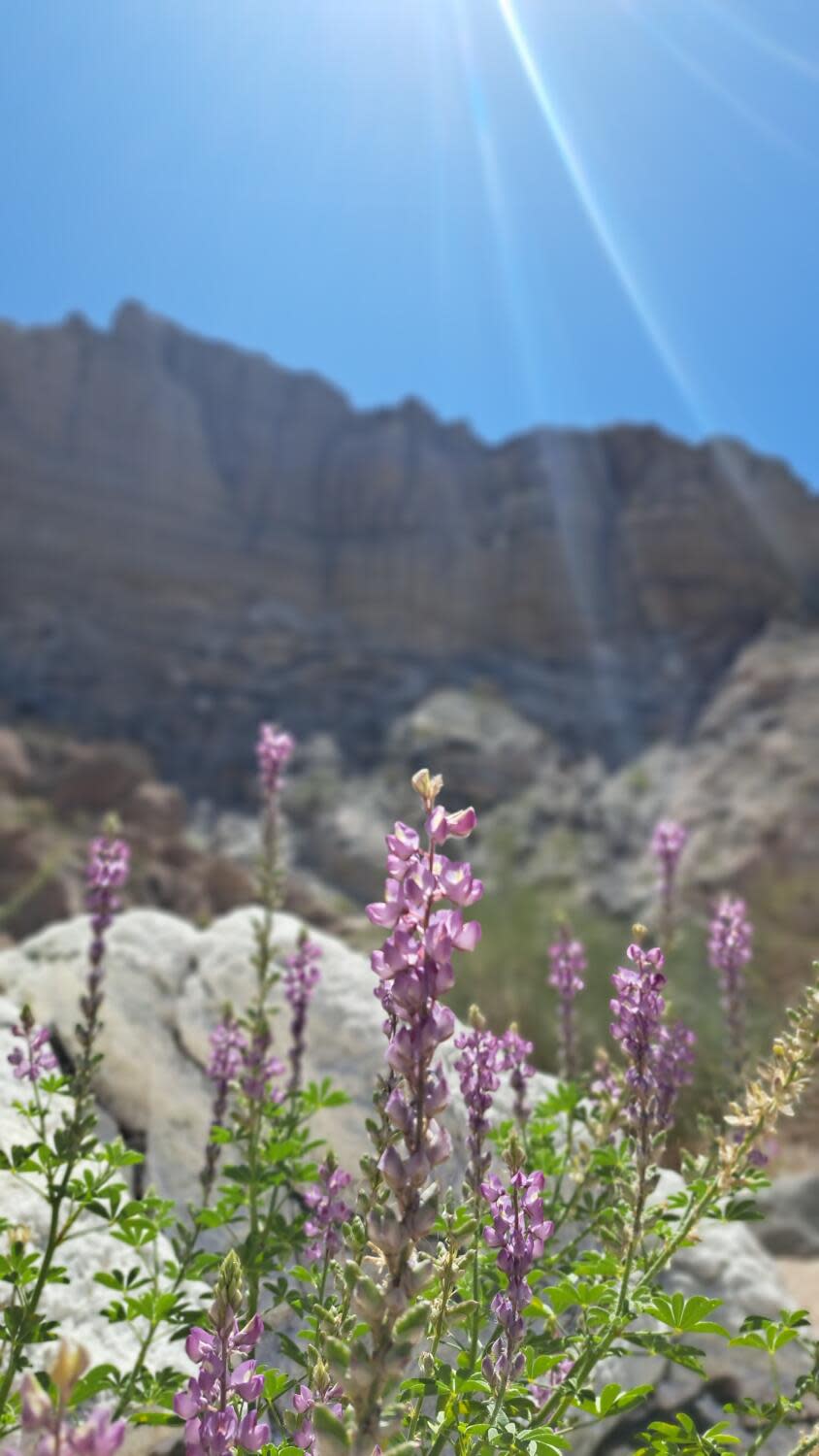

It can be hard for locals in California’s desert, many of whom are Latinos working low-wage farm jobs, to feel as if the change they see around them takes their priorities into account, Ortiz says.
“We’re always asking for more affordable housing, for more resources for low-income communities, and yet we’re met with these developments that are only meant for a few exclusive members from outside,” Ortiz says. “Some are only a few miles away from trailer home parks.”
A desire to make public lands more accessible to people of color and economically distressed communities drives an effort closer to Los Angeles, where a different coalition wants Biden to expand the San Gabriel National Monument by adding 109,000 acres of wilderness adjacent to the city.
Ortiz says Chuckwalla would be a place where those who don’t normally picture themselves in the outdoors can relax, get exercise and simply be at one with nature.
“I just feel like it’s a project that’s really for everybody,” she says.
Tortez nods. The Indigenous people of the desert have maintained bonds with each other despite forced displacement and the fact that their reservations are carved up to resemble squares on a checkerboard, interspersed with parcels that are not under tribal control.
Chuckwalla will help strengthen their sense of common cause, he says.
Tortez is proud to show a first-time visitor a side of this landscape that some outsiders might miss. He thinks again about his people’s creation story and the plight of Mukat.
Given his awesome yet unpredictable powers, many Cahuilla felt it wasn’t safe for him to live among mere mortals, Tortez says. So Mukat went to live out his days here.
Villagers communicated with Mukat by sending coyotes into the hills to bring back his messages of wisdom and warning.
Once he died and was cremated, it was said that his ashes gave rise to the same medicinal and culinary plants that Dashiell spots during the tour.
“His remains are within this area,” Tortez says. “Everything here spurred from the remains of that creator.”
Tortez stops to gaze at a cliff face that is so red it resembles dried blood and so hulking that humans look tiny by comparison.
The Cahuilla believe that red rocks are evidence of the shaman’s eternal sorrow.
“It’s a sign of his heart bleeding,” Tortez says.
As Tortez speaks, a strong, cold gust suddenly blows down through the canyon, drowning out his voice but filling him with delight.
“He heard!” Tortez yells over the force of the wind. “He can’t be seen, but he’s speaking now.”
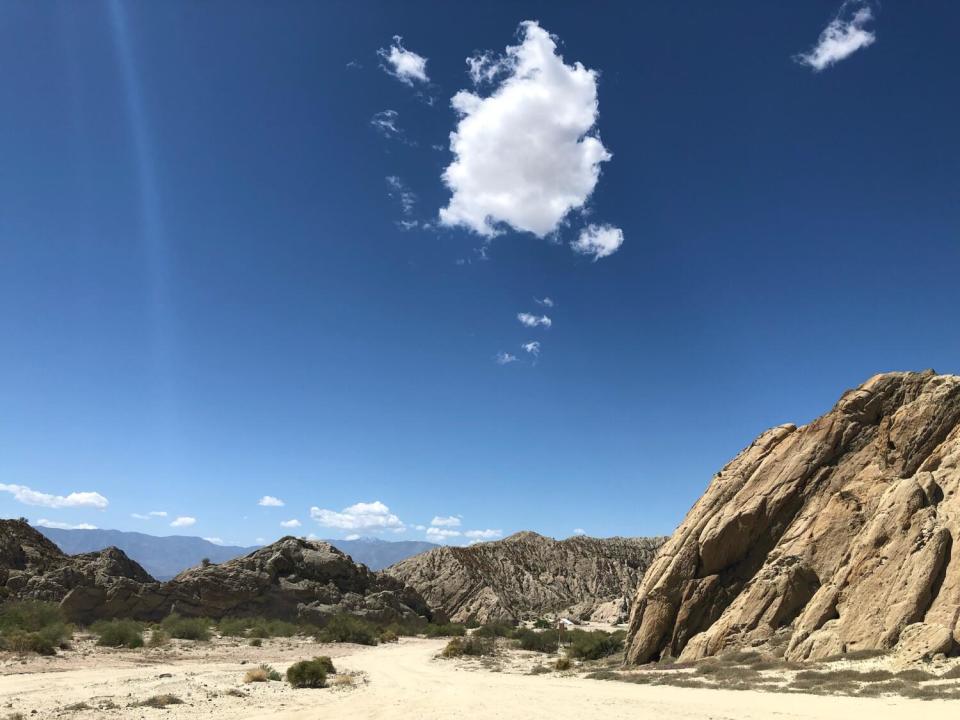

Read more: This epic slice of Arizona feeds their souls but lacks a basic necessity: Water
This story originally appeared in Los Angeles Times.


